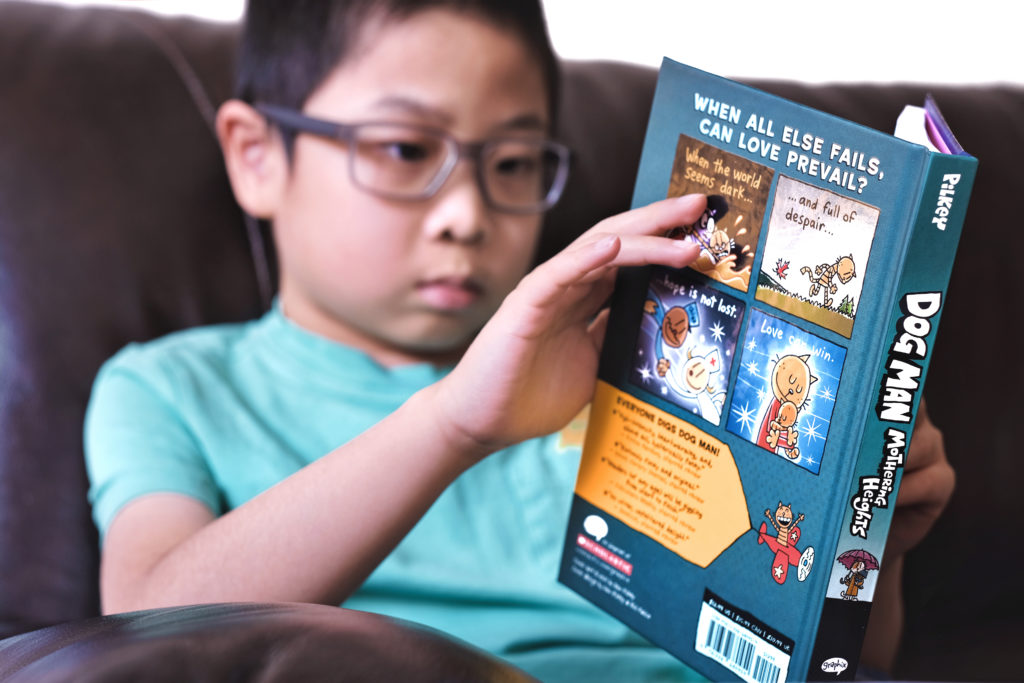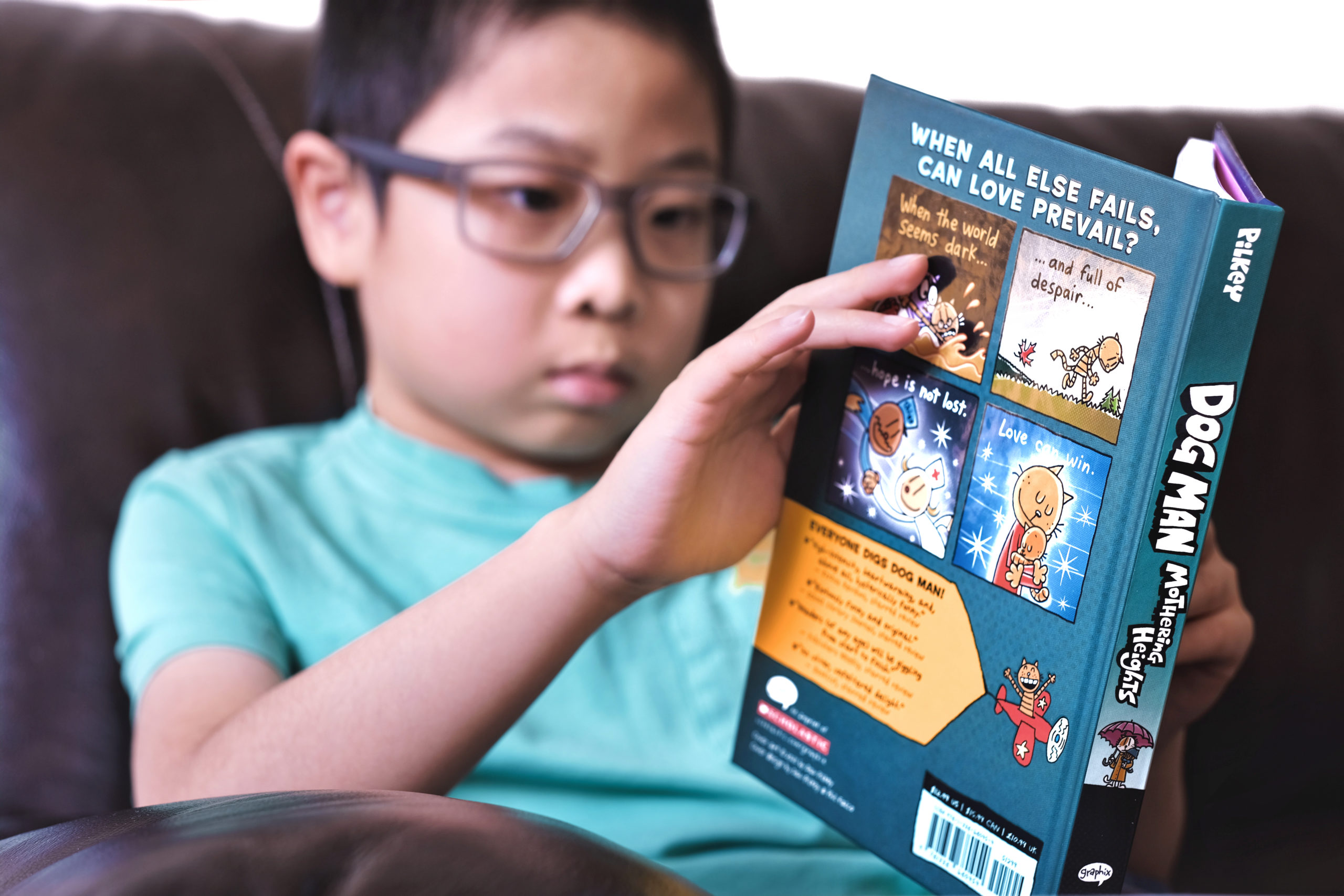
As children’s librarians at the San Antonio Public Library, pre-pandemic, we saw it all the time. A child would walk over to our graphic novel section and emerge with a gigantic smile on their face and a stack of graphic novels cradled in their arms. A few minutes later, a well-meaning parent would approach them and say that they needed to put the comics back and grab some “real books.” It is not surprising to witness this type of interaction, as graphic novels have always been controversial reading choices. In 1954, psychologist Frederick Wertham published a book called Seduction of the Innocent in which he mistakenly linked reading comic books with juvenile delinquency. Even though Wertham’s study was far from scientific, his views have distilled into our culture over the years and have led to the belief that graphic novels are not a valid, beneficial reading choice (Tilley, 2012). The question of the benefits of reading graphic novels for kids has divided many educators, critics, librarians, and parents. Therefore, it is only natural that many parents believe that graphic novels are not real books and will not benefit their children. This is not a critique of well-meaning parents. Parents are under a tremendous amount of pressure when it comes to helping their child select reading materials, especially if their child is struggling or reluctant to read. As much as possible, however, parents should allow their children to select their own reading materials and graphic novels are a valid choice.
The Benefits of Reading Graphic Novels for Kids
Visual Literacy
In our increasingly digital world, visual literacy is a necessary skill to develop. Visual literacy is defined as the ability to examine, evaluate, and interpret the meaning of visual media, such as images and videos. The images in graphic novels don’t just illustrate the words on the page—the images are just as important to the story as the text. Early graphic novels relied on big blocks of narration to tell the story, but today’s graphic novels use mainly sparse narration, snippets of dialogue, onomatopoeia, and images to tell the story. Without taking in and reading the images, a reader would not get the whole story. Readers must examine the illustrations for mood, action, expression, perspective, color, movement, and composition. Then they must synthesize the information they get from the images with the text on the page. This requires the use of higher order thinking skills. As such, comics and graphic novels meet Common Core Language Arts Standards.
Struggling and Reluctant Readers
A study including 20 participants enrolled in fourth- and fifth-grade classes between 2017 and 2019 saw the graphic novel series Fangbone! Third-Grade Barbarian incorporated into a classroom reading project that featured both independent and group collaborative work. Focusing on reading motivation and engagement, the study found that the students looked forward to these sessions and that their classroom participation increased. Students who had previously exhibited trouble remaining on task were able to do so more easily, while others who had previously avoided reading out loud in class chose to do so. Students requested graphic novels from the school and classroom libraries more frequently than they had before. It was clear that the graphic novels “resulted in positive impacts on the students’ engagement with class materials and their motivation to read” (Luetkemeyer, 2021).
For struggling readers, graphic novels are an excellent choice because the images give contextual clues to help them as they are reading. Graphic novels have really expanded in the last decade, so there is much more to offer than Dog Man and Raina Telegemeier (although both are wonderful). There are graphic novels in every genre, including informational text. Many classic works of literature that are studied in school have been adapted into graphic novels, opening the world of the classics to struggling readers. When faced with a need to reach out to students about the importance of hand-washing at the onset of the COVID-19 pandemic, the CDC provided guidelines in comic book format.
If you have a struggling or reluctant reader at home, one of the most important things you can do is surround them with books. Check out a stack of books from your local library each week and put them where they are easily accessible. Carve out some time each day to read with them. Keep trying new authors, new genres, and new subjects. Let them catch you reading and talk to them about what you are reading. Most importantly, as much as you can, let them choose what they want to read. There is a lot of pressure for children to read at grade-level, but the most important thing that children can learn is that reading is enjoyable.
Graphic Novel Recommendations
There are so many great graphic novels, but here is a mix of new and popular ones you or your child might want to check out from your local public library!
Graphic Novels for Kids Ages 5–8
Donut Feed the Squirrels by Mika Song—Best friends Belly and Norma are squirrels who are on a mission to steal doughnuts from the red food truck that has set up shop near the tree where they live. Will they be able to outsmart the humans and steal the delicious treats?
King of the Birds by Elise Gravel—Arlo the crow boasts that crows are the greatest birds in the world, but his friend Pips isn’t so sure. Arlo shares facts about crows to prove that they are the best.
Fox & Rabbit by Beth Ferry—Although they may seem like complete opposites, Fox and Rabbit are the best of friends. Together they will find everyday magic as they face their fears and find new favorite things. This is a great series for readers who are transitioning to chapter books.
Pea, Bee, and Jay Stuck Together by Brian Smith—When Pea is dared to roll all the way off the farm, he can’t resist. As he’s rolling, though, a thunderstorm bounces Pea off course and into some new friends. Can his new friends help him make it back home?
Babymouse by Jennifer L. Holm—This popular series follows Babymouse as she navigates everyday life at school, with her family, and with friends. Babymouse has a gigantic imagination, but things don’t always go the way she pictures. Luckily her friends, family, and teachers are there to help her stay positive.
Owly by Andy Runton—Try out this nearly wordless series about an owl and a worm who are best friends!
Graphic Novels for Kids Ages 8–12
When Stars are Scattered by Victoria Jamieson and Omar Mohamed—This graphic novel is based on Mohamed’s childhood and tells about when he and his younger brother lived in a refugee camp after fleeing Somalia.
Witches of Brooklyn by Sophie Escabasse—After Effie’s mother dies, she must move in with her strange Aunt Selimene. While living with her Aunt, she starts to realize that she might have magical powers!
Twins by Varian Johnson and Shannon Wright—Sixth Grade brings a lot of changes for twins Francine and Maureen Carter. For the first time, the twins aren’t in the same classes. When they decide to run against each other for student council president, will they ruin their special bond?
Hazardous Tales series by Nathan Hale—Take a trip through history with this series that is filled with action and adventure.
Max and the Midknights—When his Uncle Budrick is kidnapped, Max must team up with some new friends, the Midknights, and figure out how to rescue him.
Read More About Graphic Novels for Kids and Reading Motivation
- “Leveraging High-Interest Graphic Novels to Address Reading Motivation and Student Engagement,” Jennifer R. Luetkemeyer, Teacher Librarian February 2021.
- “The ‘Bane of the Bassinet’? Graphic Novels as Informational Texts,” Soline Holmes and Alicia Schwarzenbach, Children & Libraries: The Journal of the Association for Library Service to Children Winter 2020.
- “Seducing the Innocent: Fredric Wertham and the Falsifications That Helped Condemn Comics,” Carol L. Tilley, Information & Culture October 2012.
Resources for Teaching Literacy at Home
- “How to Teach Your Child to Read,” San Antonio Charter Moms, August 20, 2020
- “Audiobooks Bring the Joy of Reading to Your Busy Life,” Carly Friedman, San Antonio Charter Moms, July 13, 2020
- “Host a Book Swap,” Carly Friedman, San Antonio Charter Moms, June 9, 2020
- “San Antonio Summer Reading Programs,” Amy Johnson, San Antonio Charter Moms, June 18, 2019
- “Bexar County’s Bibliotech Digital Library,” Amy Johnson, San Antonio Charter Moms, April 2019
Helping Children with Dyslexia Find Joy in Reading
This blog post came about through a collaboration with Celebrate Dyslexia, a nonprofit organization dedicated to fostering a community that celebrates, educates and empowers those with dyslexia.
- “One Mom’s Experience with a Dyslexia Simulator,” Bekah McNeel, San Antonio Charter Moms, June 24, 2020
- “Celebrate Dyslexia: Education, Identification, and Celebration of Dyslexic Students,” Bekah McNeel, San Antonio Charter Moms, June 10, 2020
Charter Moms Chats
Watch Nicole Cubillas and Kristin Yourdon, Children’s Librarians with the San Antonio Public Library, along with Jasmin Dean, Executive Director of Celebrate Dyslexia, speak with Inga Cotton on Charter Moms Chats on April 15, 2021 at 4:00 PM Central live on Facebook and YouTube.
Nicole Cubillas has been a Children’s Librarian with the San Antonio Public Library for four years. She graduated with her Master’s in Library and Information Science from Louisiana State University in 2013 and has worked in law, government, and academic libraries. When Nicole isn’t playing with glitter or singing silly songs to children, she writes and creates mixed-media artwork.
Kristin Yourdon is a Children’s Librarian with the San Antonio Public Library. Yourdon earned her Master’s in Library and Information Science at the University of Illinois at Urbana-Champaign in 2013. Yourdon has a passion for sharing books with children, including her own two children, who are currently five and two.
Jasmin Dean is the Executive Director of Celebrate Dyslexia, a nonprofit organization dedicated to fostering a community that celebrates, educates and empowers those with dyslexia.
